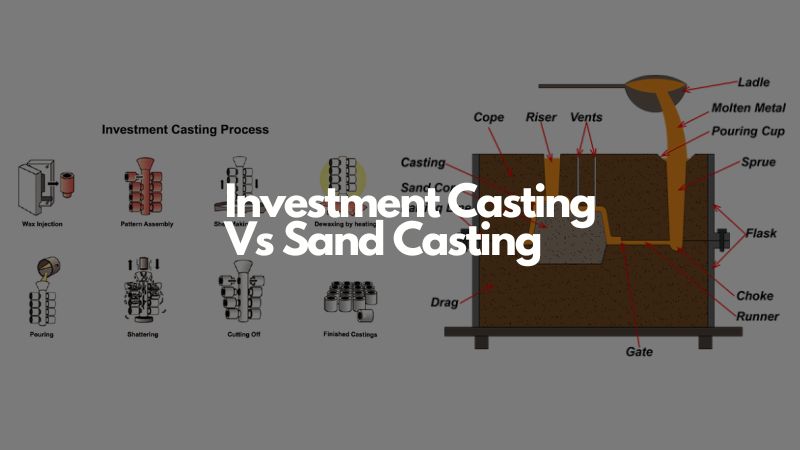A Comparative Analysis of Investment Casting and Sand Casting in Metal Component Manufacturing
Introduction: Metal casting methods play a crucial role in producing diverse components, and two prominent techniques are investment casting and sand casting. Each method offers unique advantages, making them suitable for specific applications. This article aims to provide a comprehensive comparison of these two processes to assist manufacturers and customers in choosing the most suitable technology for their applications.
 Production Volume: Sand Casting Vs Investment Casting
Production Volume: Sand Casting Vs Investment Casting
Investment casting is suitable for large volume production.
Contrarily, sand casting poses a design challenge in making castings especially with cavities making it unsuitable for high volume productions.
Key Applications:
| Applications of Investments Casting | Applications of Sand Casting |
| Making complex and precise parts and components for aerospace and defense: such as turbine blades. | Used in the automotive industry to produce parts such as engine blocks and cylinder heads. |
| Medical devices like implants and surgical instruments with high accuracy and surface finish. | Industrial machinery components like valves, pumps and compressors. |
| Automotive components with complex design such as brake parts, engine parts and suspension components. | Large agricultural machinery parts like plows and cultivators. |
| Detailed jewelry items such as medals. | Making art pieces such as sculptures. |
| Fine artistry depicting intricate shapes and features. | High strength aerospace components such as engine components and landing gears. |
Investment Casting:
Investment casting, employing the lost wax method, is a precision casting process for crafting metal components. Manufacturers use a wax pattern to create a mold, dipping it into a refractory slurry made of materials like plaster of silica. After removing the wax, molten metal is poured into the mold, creating precise components. The process is known for its accuracy, suitability for thin-walled parts, and the ability to achieve smooth surface finishes.
Advantages of Investment Casting:
Cast ferrous and non-ferrous materials
Smooth surface finishes reduce machining and finishing
Suitable for thin-walled parts with complex shapes
High accuracy, creating products with precise dimensions and net shape
Disadvantages of Investment Casting:
Higher cost compared to sand casting
Longer lead time
Sand Casting:Sand casting is a method of producing castings in a sand mold, widely used for steel, iron, and non-ferrous alloy castings. It is a cost-effective process with molds that are easy to manufacture and adaptable to various production scales.
Advantages of Sand Casting:
Lower mold costs
Suitable for casting ferrous and non-ferrous materials
Ability to cast large components
Disadvantages of Sand Casting:
Less accurate compared to other casting methods
Difficult to cast components with predetermined weight and size specifications
Rougher surface finish
Differences between Investment Casting and Sand Casting:
Design: Investment casting allows for intricate features and complex shapes, providing greater design freedom. Sand casting designs are often limited by the necessity for tapered shapes and challenges in creating internal voids or cavities.
Materials: Investment casting uses higher-cost materials like polyethylene, paraffin wax, sodium silicate, and silicon sol. Sand casting utilizes more affordable materials such as clay sand or chemical self-hardening sand.
Casting Time: Investment casting has a longer molding process, while sand casting and resin sand offer shorter cycles and higher efficiency.
Appearance Quality: Investment castings typically exhibit a higher surface quality, while sand castings may show defects like sand inclusion, sand wash, clip sand, and air holes.
Dimensional Tolerance: Investment castings achieve higher dimensional tolerance (CT 4-6) compared to sand castings (CT10-13).
Mass Production: Investment casting ensures consistency, while sand casting may face challenges in achieving casting uniformity without advanced equipment.
Products Range: Investment casting is commonly used for steel castings, especially for smaller components (<20 kgs). Sand casting is versatile, suitable for cast iron, steel castings, and cast aluminum parts, accommodating a broad range of sizes and complexities.
Conclusion: Understanding the distinctions between investment casting and sand casting is crucial for selecting the appropriate method based on the specific requirements of the application. Each process has its merits, and the choice depends on factors such as accuracy, cost, production scale, and the nature of the components being manufactured.
Dongrun Casting have 20000 square meters facility houses and 200 production & test equipment, From quotation and tooling design to casting and finished machining, we can work with you at every stage. We serves wide range of industries-from Fortune 500 corporations to small and midsize OEMs. Our products includes: Automotive&Trucking, Electric Utility & Communications, Metering System, Hydraulic Industry, Medical Devices, Lighting, Fuel and Gas Pressure, Furniture parts.
More Details : www.dongruncasting.com
